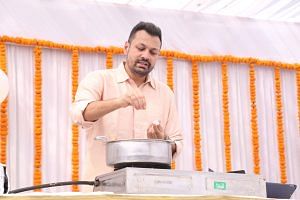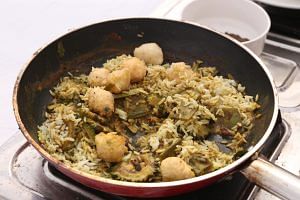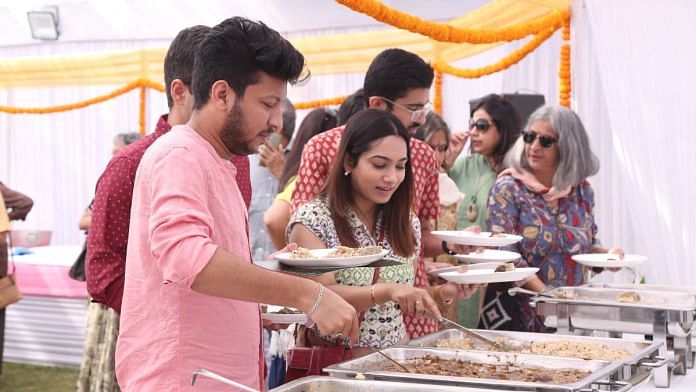New Delhi: Rakesh Raghunathan wants to document the marriage of food and faith. And in his re-telling of sacred offerings, he is the priest. The recipes are his mantras and Sangam literature, his holy book. From the ghee-laden Tirupati laddoos to Sabarimala’s aravana payasam, kada prasad from Gurdwara Bangla Sahib and dried apples from Vaishno Devi, the chef, food historian and vocalist has spent years documenting this history of holy fare, and advocating for a “return to the roots”.
His travelling temple, ‘Sacred Offerings: Poetry in Food’ is a culmination of his work, a hybrid history lesson, concert and cooking show. He has taken it around the world, from London to Singapore. It is the beating heart of Raghunathan’s mission to revive hyper-local, seasonal, and mindful eating and cooking practices.
His latest stop was Delhi’s India International Centre, where he celebrated prasadam from temples in South India. Standing behind his altar, set up with a stove, the mise en place and an iPad, Raghunathan began by dispelling a myth—that temple food is always sattvic and vegetarian.

Raghunathan prepares South Indian temple delicacies for his audience. It is his life’s mission to introduce little known local recipes to a wider audience | By special arrangement
“There’s a temple in Kerala where the offerings are dried fish” he said. But that was not reflected in the all-vegetarian lunch menu in Delhi.
There is some resistance to meat-based offerings.
“It obviously comes from a lot of privilege. The higher you are [in the class and caste hierarchy], you won’t even think of non-vegetarian food as prasadam. Whereas the common man, who is right there at the bottom, it’s what he can afford [dried fish, toddy, etc.] that he’s offering to the lord,” Raghunathan told ThePrint before diving into his multi-sensory presentation of faith, fasting and feasting.
Also read:
The beauty of ‘thirumalai champa’
The familiar throngs of Carnatic music reverberate through the pandal. Raghunathan breaks into song, and an enthralled audience leans in to listen to Thirupallandu, a poem by Tamil poet-saint Periyalvar that is recited in the mornings at Vaishnavite temples.
As the song ends, the stove is switched on, and Raghunathan seamlessly slips into his chef shoes. The first of two live demonstrations of the day featured akkaravadisal, a sweet pongal-like dish. However, his second dish, the thirumalai champa from Tamil Nadu’s Sowmyanarayana Perumal Temple, is what truly represented his mission—to make unknown hyper-local recipes available to a wider, younger audience.

“I got curious about food histories when I kept running into this narrative of ‘we can’t make it like the previous generation’,” he said. Information is the key to preservation, he stressed.
“The recipe [for thirumalai champa] is inscribed on the temple walls. You can make out the cooking techniques, the ingredients and the culture of the people in the community with this one prasadam,” he said.
The dish itself is the rustic version of a sambar sadam, but without lentils and red chillies. It starts, like most recipes in South India do, with ghee, mustard seeds and curry leaves. Into this goes what he calls country vegetables—bitter gourd, broad beans and cluster beans—along with turmeric, tamarind water and cooked rice.
“What gives the dish its unique flavour is the dark roasted methi [fenugreek] seed powder and dark roasted black pepper powder,” said Raghunathan, adding that, because of its bitter notes, the dish is an acquired taste.
The food changes every time Raghunathan has a session. But he tends to stick to prasadam from Vaishnava temples for his on-stage demonstrations, for it “lends itself more to songs, the canvas you can paint on is wider.”
Also read:
‘Rice is an emotion’
On stage, he extolled the virtues of rice—a key feature of temple cuisine. “When I did this event in Singapore and Malaysia, they asked me if I could do it without carbs,” he laughed, shaking his head.
Rice is an emotion, Raghunathan said, “especially in South India”. And he went back to Sangam literature to prove his point. “They had such beautiful, evocative names for rice. Ottadai was called so because it looked like a cobweb, thogai samba looked like peacock feathers, seeragai samba, which looks like jeera [cumin seeds], is a common one even now.”
He then threw a question at the audience—how many varieties of rice did we have then? “One lakh; 5,000; 28,000,” it shouted. “Three lakh fifty thousand,” Raghunathan answered as attendees gasped in unison.
“Food is medicine, and medicine is rice. Even an Ayurveda poultice has rice. There are varieties of rice that help in managing diabetes,” he added.
The last point caught the attention of some older guests. A curious attendee wanted to know what kind of rice Raghunathan was talking about. Mappillai samba, said the chef.
Another question about the origin of these rice varieties allowed Raghunathan to touch upon a focus area of his research: tribal food and culture.
“Most rice varieties did not come from tribal communities. They were more involved in growing millets. Today, we’re talking a lot about the grains when the conversation should be about the tribes,” he said.
The thirumalai champa was finished with a handful of urad dal bondas and another poem by Periyalvar — the 54th verse of the Divya Prabandham.
“One bite of the gravy-soaked bondas can take you heaven,” he said. That was the cue; the audience left to load up their plates for a taste of the divine.
(Edited by Zoya Bhatti)



